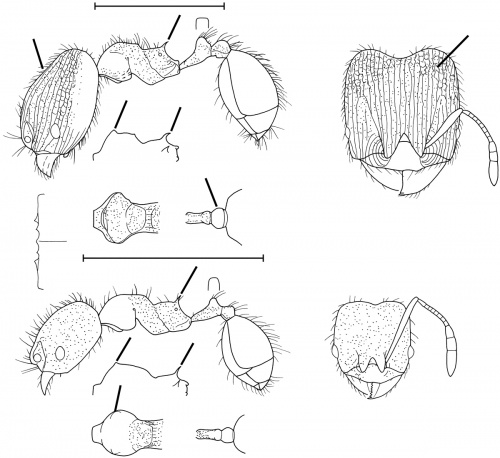Pheidole xyston
| Pheidole xyston | |
|---|---|
| Scientific classification | |
| Kingdom: | Animalia |
| Phylum: | Arthropoda |
| Class: | Insecta |
| Order: | Hymenoptera |
| Family: | Formicidae |
| Subfamily: | Myrmicinae |
| Tribe: | Attini |
| Genus: | Pheidole |
| Species: | P. xyston |
| Binomial name | |
| Pheidole xyston Wilson, 2003 | |
Philip Ward took the San Andrés Tuxtla series from a rotten log in cloud forest. (Wilson 2003)
Identification
See the description in the nomenclature section.
Keys including this Species
Distribution
From Wilson (2003): Known only from the type series and from a second series collected 11 km north of San Andrés Tuxtla, Veracruz, at 1400 m, col. P. S. Ward.
Latitudinal Distribution Pattern
Latitudinal Range: 19.5116667° to 17.133°.
| North Temperate |
North Subtropical |
Tropical | South Subtropical |
South Temperate |
- Source: AntMaps
Distribution based on Regional Taxon Lists
Neotropical Region: Guatemala, Mexico (type locality).
Distribution based on AntMaps
Distribution based on AntWeb specimens
Check data from AntWeb
Countries Occupied
| Number of countries occupied by this species based on AntWiki Regional Taxon Lists. In general, fewer countries occupied indicates a narrower range, while more countries indicates a more widespread species. |

|
Estimated Abundance
| Relative abundance based on number of AntMaps records per species (this species within the purple bar). Fewer records (to the left) indicates a less abundant/encountered species while more records (to the right) indicates more abundant/encountered species. |

|
Biology
Castes
Nomenclature
The following information is derived from Barry Bolton's Online Catalogue of the Ants of the World.
- xyston. Pheidole xyston Wilson, 2003: 535, figs. (s.w.) MEXICO.
Unless otherwise noted the text for the remainder of this section is reported from the publication that includes the original description.
Description
DIAGNOSIS Similar to Pheidole ceibana, Pheidole lemnisca, Pheidole peltastes, Pheidole perkinsi, Pheidole renae and Pheidole tayrona, distinguished in the major by the rugoreticulate occiput, shallowly concave posterior cephalic profile, cornulate humerus, and posteriorly curving propodeal spine; and in the minor by the toothed humerus and relatively long, straight propodeal spine.
MEASUREMENTS (mm) Holotype major: HW 0.70, HL 0.78, SL 0.44, EL 0.10, PW 0.40. Paratype minor: HW 0.42, HL 0.42, SL 0.40, EL 0.06, PW 0.26.
COLOR Major: mandibles and body medium brown, rest of appendages yellowish brown.
Figure. Upper: holotype, major. Lower: paratype, minor. Scale bars = 1 mm.
Type Material
MEXICO: 7 km north of Huatusco, Veracruz, 1280 m, col. A. Newton. Museum of Comparative Zoology
Etymology
Gr xyston, shaft of a spear, referring to the long propodeal spine of the minor.
References
- Wilson, E. O. 2003. Pheidole in the New World: A dominant, hyperdiverse ant genus. Harvard University Press, Cambridge, MA. (page 535, fig. major, minor described)
- Baena, M.L., Escobar, F., Valenzuela, J.E. 2019. Diversity snapshot of green–gray space ants in two Mexican cities. International Journal of Tropical Insect Science 40, 239–250 (doi:10.1007/s42690-019-00073-y).
References based on Global Ant Biodiversity Informatics
- Dattilo W. et al. 2019. MEXICO ANTS: incidence and abundance along the Nearctic-Neotropical interface. Ecology https://doi.org/10.1002/ecy.2944
- Longino J. et al. ADMAC project. Accessed on March 24th 2017 at https://sites.google.com/site/admacsite/
- Vásquez-Bolaños M. 2011. Lista de especies de hormigas (Hymenoptera: Formicidae) para México. Dugesiana 18: 95-133
- Wilson, E.O. 2003. Pheidole in the New World: A Dominant, Hyperdiverse Genus. Harvard University Press
